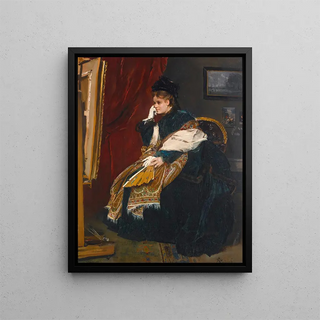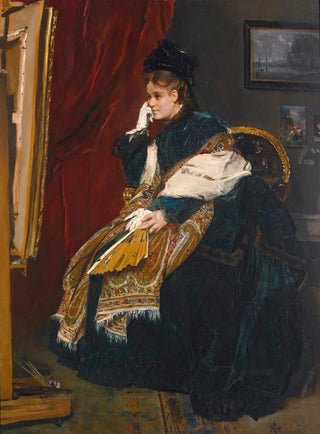Art print | The woman in green in the studio - Alfred Stevens


View from behind

Frame (optional)
The canvas "The Woman in Green in the Studio" by Alfred Stevens is an invitation to delve into a universe where beauty and intimacy converge. Painted at the end of the 19th century, this artwork reflects an artistic context where realism and impressionism intertwine, revealing a particular sensitivity to scenes of everyday life. The woman, at the center of this composition, is bathed in a soft light that highlights the richness of her clothing and the delicacy of her expression. The viewer's gaze is immediately captivated, as if invited to share a moment of complicity with this female figure, emanating both strength and gentleness.
Style and uniqueness of the work
Alfred Stevens' style is characterized by meticulous attention to detail and a refined color palette. In "The Woman in Green in the Studio," the richness of textures is striking, from the luxurious fabrics of the dress to the decorative elements of the studio. Every brushstroke seems designed to convey a tactile sensation, making this artwork a true ode to feminine beauty. The artist skillfully plays with light and shadow, creating an intimate atmosphere that invites contemplation. The composition, balanced and harmonious, highlights the figure of the woman while subtly integrating surrounding objects, silent witnesses to her daily life. This painting is not limited to a simple portrait; it tells a story, that of a woman who is both artist and muse, symbolizing the feminine emancipation of her time.
The artist and his influence
Alfred Stevens, born in 1823 in Brussels, knew how to mark his era with his innovative approach to the female genre in art. Influenced by realism and the beginnings of impressionism, he developed a style that is uniquely his own, blending tradition and modernity. His work crossed borders, reaching a diverse audience and influencing many contemporary artists. Stevens captured the essence of the modern woman, presenting her not only as an object of beauty but also as a complex and autonomous being. Through his paintings, he contributed to redefining the role of women in the

Matte finish

View from behind

Frame (optional)
The canvas "The Woman in Green in the Studio" by Alfred Stevens is an invitation to delve into a universe where beauty and intimacy converge. Painted at the end of the 19th century, this artwork reflects an artistic context where realism and impressionism intertwine, revealing a particular sensitivity to scenes of everyday life. The woman, at the center of this composition, is bathed in a soft light that highlights the richness of her clothing and the delicacy of her expression. The viewer's gaze is immediately captivated, as if invited to share a moment of complicity with this female figure, emanating both strength and gentleness.
Style and uniqueness of the work
Alfred Stevens' style is characterized by meticulous attention to detail and a refined color palette. In "The Woman in Green in the Studio," the richness of textures is striking, from the luxurious fabrics of the dress to the decorative elements of the studio. Every brushstroke seems designed to convey a tactile sensation, making this artwork a true ode to feminine beauty. The artist skillfully plays with light and shadow, creating an intimate atmosphere that invites contemplation. The composition, balanced and harmonious, highlights the figure of the woman while subtly integrating surrounding objects, silent witnesses to her daily life. This painting is not limited to a simple portrait; it tells a story, that of a woman who is both artist and muse, symbolizing the feminine emancipation of her time.
The artist and his influence
Alfred Stevens, born in 1823 in Brussels, knew how to mark his era with his innovative approach to the female genre in art. Influenced by realism and the beginnings of impressionism, he developed a style that is uniquely his own, blending tradition and modernity. His work crossed borders, reaching a diverse audience and influencing many contemporary artists. Stevens captured the essence of the modern woman, presenting her not only as an object of beauty but also as a complex and autonomous being. Through his paintings, he contributed to redefining the role of women in the






